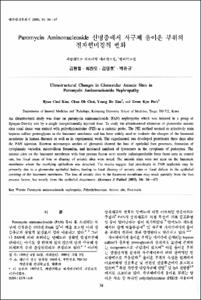KUMEL Repository
1. Journal Papers (연구논문)
1. School of Medicine (의과대학)
Dept. of Internal Medicine (내과학)
Puromycin Aminonucleoside 신병증에서 사구체 음이온 부위의 전자현미경적 변화
- Keimyung Author(s)
- Kim, Hyun Chul; Park, Kwan Kyu
- Journal Title
- 대한병리학회지
- Issued Date
- 2000
- Volume
- 34
- Issue
- 1
- Abstract
- An ultrastructural study was done on puromycin aminonucleoside (PAN) nephropathy which was induced in a group of Sprague-Dawley rats by a single intraperitoneally injected dose. To study the ultrastructural alteration of glomerular anionic sites renal tissue was stained with polyethyleneimine (PEI) as a cationic probe. The PEI method seemed to selectively stain heparan sulfate proteoglycan in the basement membrane and has been widely used to evaluate the changes of the basement membrane in human diseases as well as in experimental work. The experimental rats developed proteinuria three days after the PAN injection. Electron microscopic studies of glomeruli showed the loss of epithelial foot processes, formation of cytoplasmic vacuoles, microvillous formation, and increased numbers of lysosomes in the cytoplasm of podocytes. The anionic sites on the basement membrane with foot process fusion were mostly indistinguishable from those seen in control rats, but focal areas of loss or disarray of anionic sites were noted. The anionic sites were not seen on the basement membrane where the overlying epithelium was detached. The results suggest that proteinuria in PAN nephrosis may be primarily due to a glomerular epithelial lesion, leading to focal disarray of anionic sites or focal defects in the epithelial covering of the basement membrane. The loss of anionic sites in the basement membrane may result partially from the foot process fusion, but mostly from the epithelial detachment.
Key Words: Puromycin aminonucleoside nephropathy; Polyethyleneimine; Anionic site; Proteinuria
- Alternative Title
- Ultrastructural Changes in Glomerular Anionic Sites in Puromycin Aminonucleoside Nephropathy.
- Publisher
- School of Medicine
- Citation
- 김현철 et al. (2000). Puromycin Aminonucleoside 신병증에서 사구체 음이온 부위의 전자현미경적 변화. 대한병리학회지, 34(1), 56–67.
- Type
- Article
- ISSN
- 0379-1149
- Appears in Collections:
- 1. School of Medicine (의과대학) > Dept. of Internal Medicine (내과학)
1. School of Medicine (의과대학) > Dept. of Pathology (병리학)
- 파일 목록
-
-
Download
 oak-bbb-1102.pdf
기타 데이터 / 24.55 MB / Adobe PDF
oak-bbb-1102.pdf
기타 데이터 / 24.55 MB / Adobe PDF
-
Items in Repository are protected by copyright, with all rights reserved, unless otherwise indicated.